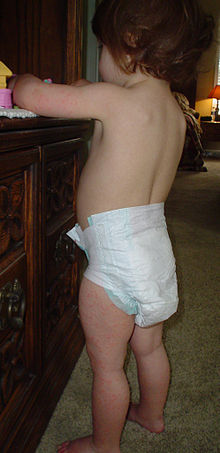Roseola: Difference between revisions
m Dated {{Failed verification}}. (Build p621) |
|||
| Line 45: | Line 45: | ||
|Greece |
|Greece |
||
|Αιφνίδιο εξάνθημα "sudden rash" (Greek) |
|Αιφνίδιο εξάνθημα "sudden rash" (Greek) |
||
|- |
|||
|Hungary |
|||
|Rózsahimlő |
|||
|- |
|- |
||
|Iceland |
|Iceland |
||
Revision as of 08:24, 7 February 2012
| Roseola | |
|---|---|
| Specialty | Infectious diseases |

Exanthema subitum (meaning sudden rash), also referred to as roseola infantum (or rose rash of infants), sixth disease (as the sixth rash-causing childhood disease) and (confusingly) baby measles, or three-day fever, is a disease of children, generally under two years old,[1] although it has been known to occur in eighteen year olds, whose manifestations are usually limited to a transient rash ("exanthem") that occurs following a fever of about three day's duration.
It is frequently called roseola, although this term could be applied to any rose-colored rash.[2][failed verification]
Until recently, its origin was unknown, but it is now known to be caused by two human herpesviruses, HHV-6 (Human herpesvirus 6) and HHV-7, which are sometimes referred to collectively as Roseolovirus. There are two variants of HHV-6 and studies in the US, Europe and Japan have shown that exanthema subitum is caused by HHV-6B which infects over 90% of infants by age 2. Some research indicates that babies congenitally infected with the HHV-6A virus can have inherited the virus on a chromosome.[3]
Clinical features
Typically the disease affects a child between six months and two years of age, and begins with a sudden high fever (39–40 °C; 102.2-104 °F). This can cause, in rare cases, febrile convulsions (also known as febrile seizures or "fever fits") due to the sudden rise in body temperature, but in many cases the child appears normal. After a few days the fever subsides, and just as the child appears to be recovering, a red rash appears. This usually begins on the trunk, spreading to the legs and neck. The rash is not itchy and may last 1 to 2 days.[4] In contrast, a child suffering from measles would usually appear more infirm, with symptoms of conjunctivitis, coryza and a cough, and their rash would affect the face and last for several days. Liver dysfunction can occur in rare cases.
The rare adult reactivates with HHV-6 and can show signs of mononucleosis.[5]
Vaccines and treatment
There is no specific vaccine against or treatment for exanthema subitum, and most children with the disease are not seriously ill. A child with fever should be given plenty of fluids to drink. Paracetamol/acetaminophen or ibuprofen could be given to reduce their temperature (but never aspirin, due to the risk of Reye's Syndrome[6]).
A small percent of children acquire HHV-6 "subclinically"; in other words, they show no outward sign of the disease. Exanthema subitum occurs in approximately 30% of children during primary HHV-6 infection [7]. Others may be debilitated enough that a doctor's opinion is required to confirm the diagnosis, and particularly to rule out other more serious infections, such as meningitis or measles. In case of febrile seizures, medical advice is essential.
Local terms
| Belgium | Driedagenkoorts "three-day fever" or zesde ziekte "sixth disease" (Dutch) - "Roséole" (French) |
| Finland | Vauvarokko "baby measles" (Finnish) |
| Germany | Dreitagefieber "three-day fever" (German) |
| Greece | Αιφνίδιο εξάνθημα "sudden rash" (Greek) |
| Hungary | Rózsahimlő |
| Iceland | Mislingabróðir "measles' brother" (Icelandic) |
| Italy | Sesta malattia "sixth disease" (Italian) |
| Norway | Fjerde barnesykdom "fourth disease" (Norwegian)[8] |
| Philippines | Tigdas Hangin "wind measles" (Tagalog) |
| Poland | Trzydniowa goraczka "three-day fever" (Polish) |
| Singapore/Malaysia | Jia3 Ma2 假麻 "false measles" (Chinese) |
| Turkey | Altıncı hastalık "sixth disease" (Turkish) |
| Israel | Adamdemet אדמדמת (Hebrew) |
| Vietnam | Sốt phát ban "baby rash" (Vietnamese) |
See also
- Human herpesvirus 7
- Endogenous retrovirus
- List of cutaneous conditions
- Roseola Infantum - Pubmed Health
References
- ^ Zerr DM, Meier AS, Selke SS; et al. (2005). "A population-based study of primary human herpesvirus 6 infection". N. Engl. J. Med. 352 (8): 768–76. doi:10.1056/NEJMoa042207. PMID 15728809.
{{cite journal}}: Explicit use of et al. in:|author=(help); Unknown parameter|month=ignored (help)CS1 maint: multiple names: authors list (link) - ^ "exanthema subitum" at Dorland's Medical Dictionary
- ^ Universal childhood virus is inherited in DNA, newscientist.com
- ^ Roseola – Topic Overview, webmd.com
- ^ Stoeckle MY (2000). "The spectrum of human herpesvirus 6 infection: from roseola infantum to adult disease". Annu. Rev. Med. 51: 423–30. doi:10.1146/annurev.med.51.1.423. PMID 10774474.
- ^ What is the role of aspirin?, reyessyndrome.org
- ^ [Zerr, Danielle M. et al. A population-based study of primary human herpesvirus 6 infection.], N Engl J Med 2005; 352:768-776
- ^ Nylander, Gro (2009) "Lille venn, hva nå?"
External links
- MedlinePlus encyclopedia entry on "roseola"
- Links to roseola pictures, Hardin MD/Univ of Iowa
- Newly Found Herpes Virus Is Called Major Cause of Illness in Young, New York Times
- HHV-6 Foundation
- DermNet viral/roseola
